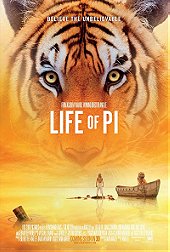Life of Pi is an adaptation of Yann Martel's 2001 novel of the same name, which is often described as "unfilmable." Yet, director Ang Lee and writer David Magee attempted it nevertheless, and the resultant movie is ultimately a mixed bag. It's certainly easy to appreciate what Lee was trying to achieve here - after all, 3-D is frequently applied to big-budget action extravaganzas, but Life of Pi aims to be an awe-inspiring visual experience that relies on the beauty of nature as opposed to colourful action scenes. While it's an incredible picture to study, it's at times a gruelling sit, with the experience ultimately becoming repetitive and exhausting. More pertinently, though, Life of Pi is built around a thematic punch-line that's such fallacious nonsense that it undermines the production as a whole.

The narrative is predominantly told in flashbacks. Pi (Irfan Khan) is visited by a writer (Rafe Spall), with whom he recounts his intimate life story. As a young man, Pi (now played by Suraj Sharma) was raised in India by his zookeeper parents, who decide to move the family to Canada for a fresh start. While en route aboard a Japanese freighter, a powerful storm sinks the ship, and Pi is the sole survivor. Scrambling on a lifeboat, Pi's only companions are a zebra, an orangutan, a hyena, and a Bengal tiger affectionately named Richard Parker. Adrift in the middle of the ocean, nature begins to take its course, leaving just Pi and Richard Parker on the boat, with the frightened Pi attempting to manage his existence and survive the ordeal without being eaten by the ferocious (and hungry) tiger.
Life of Pi would be a breathtaking experience if only it remained focused on the events that befall Pi and Richard Parker while on the lifeboat. Unfortunately, this constituent of the story takes up a bit more than half of the film's two-hour running time. Lee makes a critical error in focusing too much on Pi telling his story, for which he over-explains everything, breaking the flow and ruining the sense of immersion. Pi is one of those people who has stories for all aspects of his life; there's a tale behind how he got his name, how Richard Parker got his name, and so on. It's too self-consciously quirky. It doesn't help that most every facet of Pi's character is quirky for the sake of it - he even "collects" religions, for crying out loud. Worse, there is a big message behind Life of Pi. See, early into the film, we're told that Pi's story will make us believe in God. And late into the film, this is finally addressed. You see, Pi eventually tells an alternate version of his survival story that's more plausible, more mundane, darker, and far more depressing. Of course people prefer to hear the story with the tiger because it's more uplifting. "And so it goes with God," Pi tells the writer. In other words, we're basically being told that you should believe in God because it's more fun to do so. It's pretentious and cringe-inducing to extremes, closing the door on a sour note. Religious nuts may find it wonderful, but the rest of us will see it as the preachy bullshit that it is.

For all of the nonsense bubbling underneath Life of Pi's surface, it's hard to deny that Lee and his crew have assembled one hell of a gorgeous motion picture endowed with striking imagery. The CGI is genuinely top-notch, and the movie was magnificently photographed by Claudio Miranda. The animals are predominantly digital, yet they are staggeringly realistic, to the point that it's very hard to tell where the live-action ends and the CGI begins. Various set-pieces - including the ship's sinking, Pi's encounters with whales, and the discovery of a strange carnivorous island - all make a tremendous impression and will stick in the mind long after viewing. Not many movies are worth the 3-D experience, but it's hard to imagine seeing Life of Pi in regular old 2-D. Lee and Miranda do not use 3-D as a money-inflating gimmick but rather as a legitimate moviemaking tool that reinforces the film's central themes of distance and separation. Moreover, it emphasises the sea's great expanse, making the experience all the more immersive.
Another positive attribute is the fact that Lee is never romantic about the tiger, nor does he imbue the beast with any anthropomorphism. It's established early into the movie that this is a wild beast, vicious and meat-eating, and it is a danger to Pi while he's trapped on the lifeboat with it. While Pi refuses to kill Richard Parker, the tiger would be more than willing to devour the boy without any consideration. A growing bond does emerge, but it does feel organic to the film, which is a huge accomplishment. The animation of the tiger is extraordinary, but young Suraj Sharma also deserves plaudits. This is Sharma's first film role, yet he delivers a terrific, complex performance, and it's all the more impressive considering that he was playing opposite a digital creation that was never on set with him.

Life of Pi is treacly, self-indulgent philosophical tripe, but it's gorgeous to look at, making this one of the most spectacular visual experiments since James Cameron's Avatar. A number of filmmakers have set out to adapt the Life of Pi novel in the past (including M. Night Shyamalan), hence Lee does deserve credit for rendering this "unfilmable" novel as skilfully as he did. It's definitely worth seeing, regardless of its undeniable shortcomings.
5.8/10
 Login
Login